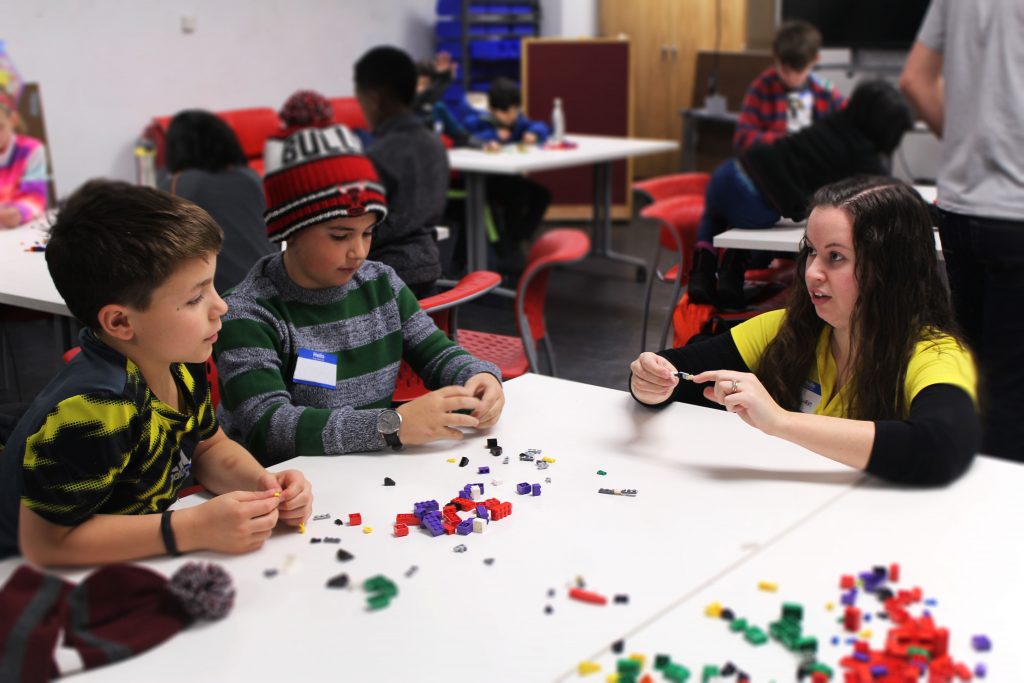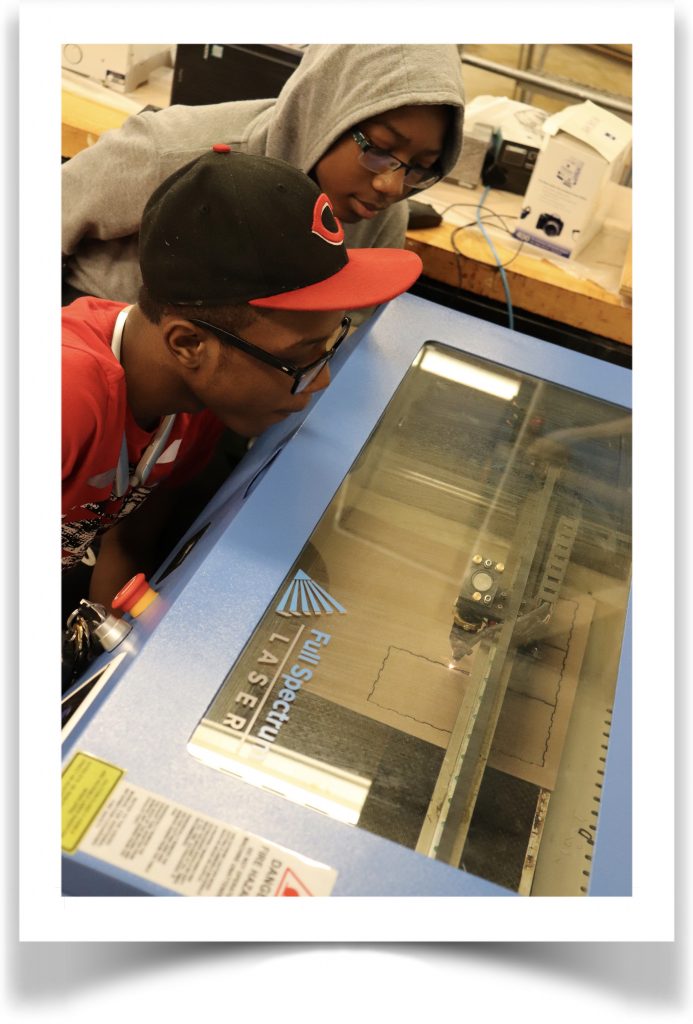Tool and Project Development
Novel Engineering: Novel Engineering is a tool that educators can use to integrate project-based design engineering with literacy and reading in their classrooms. Tufts CEEO is collaborating with the Brazil Creative Learning Network on exploring ways to implement Novel Engineering in Brazilian classrooms. Recently, we have begun talks with Humans Who Play (partnered with IREX) about incorporating Novel Engineering into their work. We are also continuing to communicate with Right to Play about finding ways that our Novel Engineering approach can be helpful to them as well.
Smart Motors: Smart motors may be an excellent tool for making robotics more accessible in classrooms. By creating kits that come pre-programmed with responsive AI, students can directly “train” their robot to function in a myriad of engineering projects rather than needing to use a traditional computer and coding language to give the robot instructions. We are also exploring the use of augmented reality and local-area networks to allow students with smartphones and computers (but no internet connection) to more deeply explore the AI within their smart actuators, and to have cross-robot collaboration in the classroom. Tufts CEEO is collaborating with the Brazil Creative Learning Network on developing smart motors for use in Brazil and is continuing to run tests with our partners in Nepal.

Both Novel Engineering and Smart Motors address systemic impact because both are low-cost, low-resource ventures that aim to be widely applicable across a broad range of educational settings. We are especially interested in exploring the use of locally-produced resources and materials for these projects. Additionally, each of these projects has the potential to be greatly expanded and enhanced if/when more resources (like computers and advanced making/tinkering materials) are made available later. Both projects are applicable in low resource and high resource environments, increasing their ability to have a large systemic impact.
Growing Opportunities for Trans-National Partnerships
Photoethnography: Building from traditions of photovoice, problem framing literature, and ethnography, we are developing ways of using photography to mediate discussions, collaborations, and the identification of problems and phenomena in one’s life and community to be centered in design and engineering contexts. Playful approaches to learning require we explore the relational aspects of learning in context, and we will develop protocols and examples of connecting engineering to one’s life. Educators at Tufts CEEO and Karkhana collaborated on a pilot project to investigate possible methods for conducting a fully virtual sharing of photos, stories, and narratives to help us better understand what engineering education is like in Nepal. We look forward to continuing to refine these methods and possibly using them to gain a more authentic understanding of the various educational landscapes we’ll be interacting with in our partner countries.
Little Singer Community School: Staff at Tufts CEEO are currently engaged in a pilot project to integrate robotics and engineering into the 6th grade curriculum at Little Singer Community School in the Navajo Nation. This pilot project explores the various aspects of teaching robotics and engineering remotely, as the whole endeavor is accomplished via Zoom sessions. It also explores co-designing curriculum with educators in a purely online environment, and working with educators and students from a different cultural background from our own here at Tufts.
Maranyundo Girls School: Educators and staff are continuing to build on connections we have at the Maranyundo Girls School in Rwanda. Through visits (pre-pandemic) and regular online communication, we have helped to foster an engineering club (that is still going strong through the pandemic!) and continue to support their maker space development.
Conducting Research & Educator Support
Our research will explore and document successful methods for decolonizing cross-cultural partnerships as well as the approach and impact of the co-design of teacher education resources for Novel Engineering.

Co-design of Novel Engineering Educator resources for professional learning can look like sample books, classroom video, and structures for engaging teachers in doing engineering that are entirely accessible online.
Design-Based Research
At Tufts CEEO, we use Conjecture Mapping as a powerful tool to guide design-based research in education. This approach begins with high-level conjectures that are used to guide the decision making around design elements and activities that unfold in iterative cycles of action and revision. Conjectures lay the foundation for what we imagine is possible, liking the design elements themselves with theory and research on learning and teaching. In so doing, the resulting observable activities (called “meditating processes” in conjecture mapping circles) provide not only evidence to evaluate the conjecture, but also evidence to support the development of us to both “do” the partnerships, while also studying our decisions and how they play out in interactions with different partners. Thus, we can answer questions related to build-test-learn cycles from within the designs, as opposed to having evaluation operate as an external process. We intend to utilize this method as our way of contributing to the exploration of other MELtP practices that the LEGO Foundation is providing in the Tech and Play CoP. Some of the high-level conjectures/assumptions we intend to explore are:
- The co-design of Novel Engineering with Tech and Play partners builds collaborations and partnerships that are culturally sustaining.
- Materials mediate how individuals play with and evolve ideas and designs.
- Computer-free robotics and sensors broaden access to robotics and learning advanced artificial intelligence topics
The first assumption addresses the local barriers and opportunities we anticipate will arise by working with cultures that are different from our own. In order to learn what motivates students (and teachers) in foreign classrooms, our work starts with learning from our local partners in these different cultural and geographic settings. We believe by doing the work of learning from local partners and keeping collaboration as an equitable two-way flow of information and ideas, we can reduce common barriers in cross-cultural partnerships such as false assumptions, miscommunications, and erasure of local cultural touchstones in favor of our own ways of thinking. In this way, we hope to find opportunities to ensure that our work has a lasting, positive impact in our partner countries and in our work.
The second assumption addresses the local barriers and opportunities associated with educational materials, both their acquisition and use. We have been interested to explore the interplay between materials, facility with materials, and design ideas. This draws from classroom experiences where using interesting and new-to-them materials drove more of students’ design decisions than the context or problem. We are also drawing on Brian Gravel’s work on the importance of tinkering and material “play” in engineering. We are coming to understand that the barriers around acquiring foreign materials in our partners’ local educational settings are significant. With this in mind, we recognize that there are rich opportunities to explore the use of local materials and products. In one aspect, the use of local materials avoids the financial and logistic barriers of shipping foreign materials while reducing the global environmental impact of the product production and shipping. In another aspect, the use of local materials can uplift the cultural norms and traditions of local makers and craftspeople as well as potentially have a beneficial impact on the local economy. Most importantly, we wish to investigate how the use of local materials impacts student learning and thinking. Related to this work, we are focusing efforts on developing locally produced tools and materials in Brazil. Currently, we are in talks with our partners at Arduino to have specially-designed electronics boards manufactured in Brazil.
The third assumption addresses the local barriers and opportunities surrounding access to computers and coding in local learning environments. We are becoming aware that many classrooms we wish to impact have significant barriers to robotics learning experiences due to a lack of internet connectivity and computer resources. At the same time, we believe that knowledge and skills related to robotics and artificial intelligence are rapidly becoming an important fixture of 21st century life world-wide. We are excited to explore our assumption that providing computer-free robotics technology is an opportunity to allow students to play with robotics and automation, expanding students’ 21st century skill sets as well as reducing the local barriers of connectivity and computer access.
Core Values that Tufts CEEO Brings to Tech and Play

- We support teachers around the world to bring engineering thinking into their classrooms.
- We support student-driven learning, creativity, and innovation through Learning through Play.
- We are dedicated to diversity, equity, inclusion, justice, and decolonizing education.
- Decolonizing education, focusing on co-developing content/projects with educators and local experts rather than deploying readymade “solutions” we have developed ourselves. We are “educator-focused”.
- Asset-based approaches to schools and educators, not a deficit approach. All children (and educators!) are learners and can do engineering.
- Student opinions and inventions are important, even if they disagree with convention.
- Engineering can be a humanizing activity.
- Successful STEM projects in the classroom usually have a large diversity of solutions (and paths to solutions).
Areas of Interest and Focus that Tufts CEEO Brings to Tech and Play
Technology Design – Tufts T&P researchers and educators have developed an approach to designing technologies that foreground student agency and provide access to new ideas in science and engineering. Moreover, they consider how tools can support students exploring ideas in multiple disciplines – including literature, social studies and more.
Meaningful Teacher Learning – CEEO researchers and professional development providers are studying and reimagining teacher learning to leverage teachers’ assets, create space for them to unpack their own historic disciplinary experiences, and provide time and space for them to explore the tools and disciplinary ideas as adult learners. Regarding Tech and Play, we wish to work with our partners to identify teachers already using LtP techniques and find ways to support and empower them. When skilled teachers are empowered to spread their best practices to their own communities and educator networks, this produces an organic kind of “scaling” that is far more effective in creating lasting change.
The connection between play, engineering, and the next generation of innovators – The problem solvers of tomorrow won’t be filling in worksheets to tackle global grand challenges like renewable energy, clean water, broader access to health and educational resources and more. They will be asking new questions, combining ideas in new ways, and reaching across systems and structures to imagine new solutions. To be those future changemakers, we need to create opportunities for learners to engage with tools that allow them to build solutions to challenges and in contexts that support thinking, designing, and making across disciplines.
